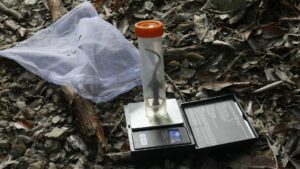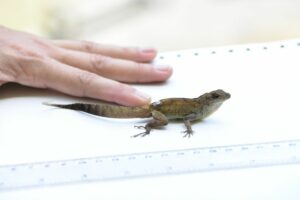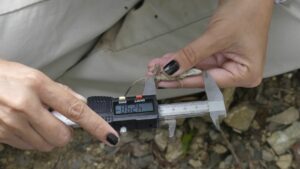In Cuba as elsewhere, urbanization is increasing, affecting many animal species. In a recently published study, researchers studied the behaviour of an endemic species of the island, the lizard Anolis homolechis, by comparing forests and suburban populations.
The urbanization of environments is characterized by numerous disturbances for wildlife: fragmented food resources, proximity to humans, presence of pollutants, a dryer and warmer microclimate, etc. These changes are often the cause of a loss of biodiversity. To survive in such environments, species must be able to adapt shortly. Variations in their behaviour can then play a key role in allowing a rapid response to environmental changes.

Annabelle Vidal studying lizards in a suburban environment.
Lizards of the anole group provide a good model to better understand the effects of urbanization. Comparisons between populations in urban and non-urban environments showed many differences, including in their behaviour. However, such comparisons have mainly been carried out in invasive species, which likely have a greater potential for adaptation, including through flexibility in their behaviour. To verify whether these findings also apply to non-invasive species, Dr. Annabelle Vidal studied the lizard Anolis homolechis, endemic to Cuba.
No less than 779 individuals were captured, both male and female, in two forests and two urban areas on the island. For each capture, the researcher noted the height at which the animal was perched, a parameter known to be influenced by multiple factors. Individuals were measured, weighed and sexed. In addition, nearly 200 individuals were marked with a numbered tag, allowing remote recognition. Thanks to this marking, Annabelle Vidal recorded videos of 81 individuals to obtain more detailed behavioural data.

Weighing of an individual.
In a previous study, the author already found that urbanization affect the size and body condition in this species (read the article). The results of the present study show that a difference is also observed in the behaviour of anoles living in forests compared to those from suburban environments. Indeed, lizards perched higher in urban environments compared to forest environments. This difference could be explained by an overall higher temperature in urban areas, a parameter known to influence the perch height of anoles. Lizards in urban areas could also benefit from an improved visibility of the surroundings in open suburban areas, compared to closed spaces, such as forests.
Other parameters measured were also found to influence perch height, in particular the size of individuals. Analyses showed that larger individuals tended to perch higher. Contrary to other studies, no difference was found between males and females was found. This could be due to the sexual dimorphism found in this species. Indeed, males are overall larger than females. Thus, although males do perch higher in general, such effect is mainly due to their bigger size. The effect body size on the perch height could be explained by a dominance of the largest individuals, or simply by their better climbing efficiency, thanks to larger toepads and bigger claws.

Animals are identified with a numbered tag.
Finally, the study found that the behaviour of lizards differed according to the time of day, but only in the urban environment: lizards perched higher in the afternoon compared to the morning. The authors explain that predation risk could be higher in the afternoon in urban areas, but not in forests, causing this behavioural response.
In conclusion, the study shows that urbanization influences the behaviour of anoles. It also shows, as the authors suspected, that invasive and endemic species have different responses to urbanization. Indeed, studies conducted on A. sagrei and A. cristatellus, two species known for their high invasive potential, found no difference in perch height between urban and non-urban environments. Such a difference highlights the importance of studying the effects of environmental change not only on invasive widespread species, but also on native species.

Measurement of an anole lizard
Reference
Vidal, A., Pradel, R. & Cézilly, F. (2023). Do suburban populations of lizards behave differently from forest ones? An analysis of perch height, time budget, and display rate in the Cuban endemic Anolis homolechis. Diversity 15: 261.

